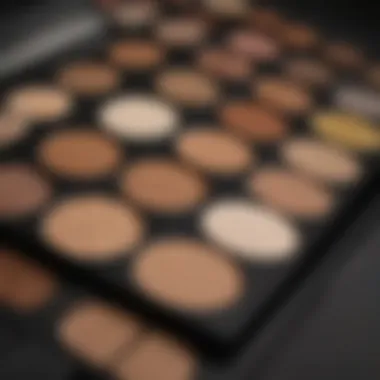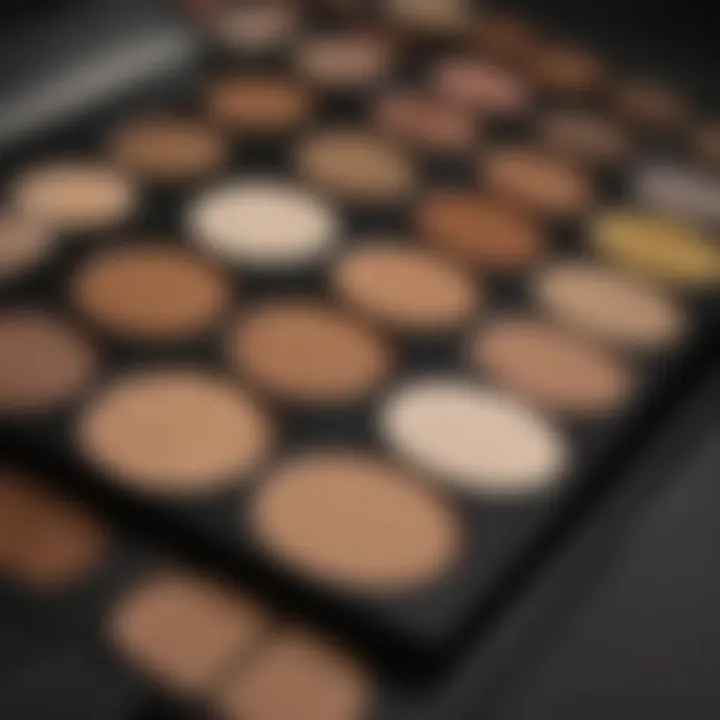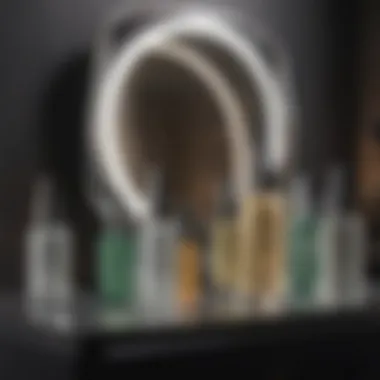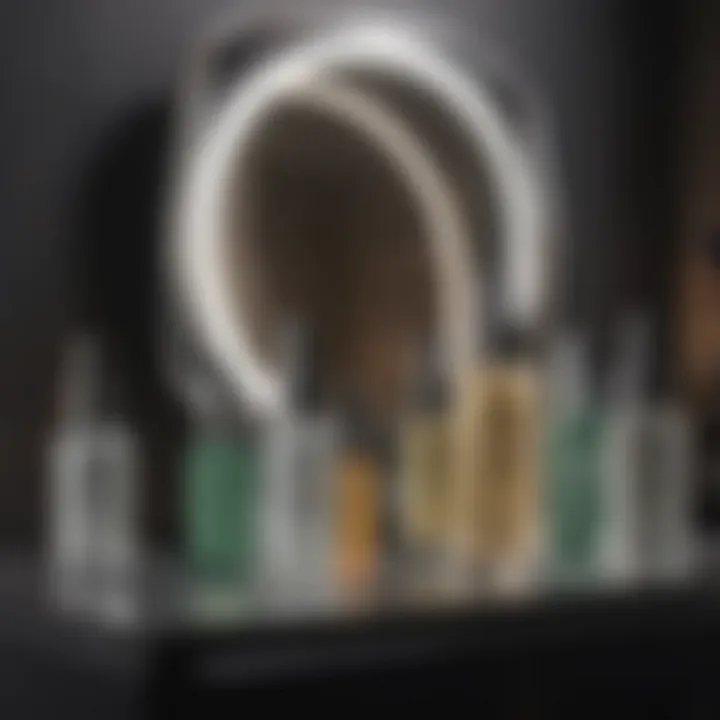Mastering Full Coverage Makeup for Oily Skin


Intro
Achieving full coverage makeup for oily skin is a nuanced endeavor. Those with this skin type face a set of unique challenges that can complicate the makeup application process. Oily skin often leads to shine, which can disrupt the appearance of foundation and other products. Moreover, some formulations do not adhere well throughout the day, leading to a need for constant touch-ups. Understanding these challenges is crucial for selecting the right products and techniques.
In this guide, we will explore appropriate skincare routines, product recommendations, and application methods tailored specifically for oily skin. By addressing the intersection of cosmetics and skin health, readers can enhance their makeup skills while ensuring that their skin remains in optimal condition.
Tips and How-Tos
Skincare Routines for Oily Skin
The foundation for successful makeup application begins with a solid skincare routine. Oily skin requires specific care to manage excess sebum production and maintain balanced hydration. Here are some essential steps:
- Cleanser: Choose a gentle foaming cleanser to remove excess oil without stripping the skin of its natural moisture. Look for ingredients such as salicylic acid that can help prevent breakouts.
- Toner: Using an alcohol-free toner can help to tighten pores and remove residual oil, setting the stage for makeup.
- Moisturizer: Lightweight, oil-free moisturizers are ideal. They provide necessary hydration without adding extra shine.
- Primer: A mattifying primer creates a smooth base for makeup and helps to control shine throughout the day.
Application Techniques
Proper application techniques can enhance the longevity and appearance of your makeup. Consider these tips:
- Foundation: Opt for full coverage foundations designed for oily skin. Products like Estée Lauder Double Wear or Fenty Beauty Pro Filt'r Matte can provide a long-lasting finish.
- Setting Powder: A translucent setting powder can absorb excess oil and help in minimizing shine. Focus on areas prone to oiliness such as the T-zone.
- Mist Sprays: Finish with a setting spray formulated for oily skin to prolong wear and keep your makeup intact.
Maintaining the Look
It is essential to maintain your makeup throughout the day to avoid any meltdowns. Consider handy tools:
- Oil Blotting Sheets: These can absorb excess oil without disturbing makeup.
- Travel-size Products: Keep small versions of your foundation and setting spray for quick touch-ups on the go.
By adopting these practices, individuals with oily skin can achieve and maintain full coverage makeup effortlessly.
Oily skin needs a dedicated approach to skincare and makeup application to thrive. Prioritize products that cater specifically to oily skin to see the best results.
End
This guide emphasizes the importance of tailoring specific products and routines to oily skin type. Through a combination of careful skincare, appropriate makeup choices, and effective application techniques, achieving full coverage can be a straightforward task. By embracing these strategies, individuals can enjoy not only a flawless look but also healthy skin.
Understanding Oily Skin
Understanding oily skin is crucial for achieving successful full coverage makeup. Oily skin often brings its own set of challenges, including excess shine and difficulties with product adherence. By grasping the characteristics and needs of oily skin, individuals can make informed decisions regarding the selection of makeup products and techniques. This understanding not only enhances the appearance but also maintains skin health, leading to an overall better makeup experience.
Characteristics of Oily Skin
Oily skin is typically characterized by an overproduction of sebum. Sebum is the natural oil produced by the skin, and while it is essential for keeping the skin hydrated, excess production can lead to a shiny complexion. Those with oily skin may notice enlarged pores, particularly on the forehead, nose, and chin. These characteristics can lead to a more luminous look, which may be desirable, but can also result in makeup sliding off throughout the day.
A few common traits of oily skin include:
- Shiny Appearance: A noticeable sheen, especially in the T-zone (forehead, nose, chin).
- Enlarged Pores: Clogged pores that can be more visible.
- Prone to Breakouts: Higher likelihood of acne and other blemishes due to clogged pores.
Common Skin Issues Associated with Oily Skin
Oily skin can lead to several skin concerns that require attention. One of the most frequent issues is acne, which stems from clogged pores. Additionally, individuals may encounter blackheads and whiteheads more often.
Other common issues include:
- Shiny skin throughout the day: This can be frustrating, especially for makeup wearers.
- Foundation breakdown: Makeup can fade or slide off if not applied correctly.
- Increased sensitivity: Some individuals may experience sensitivity or irritation due to the constant battle with oil production.
Understanding these issues is a step toward finding the right solutions.
The Role of Genetics in Oily Skin
Genetics play a significant role in skin type. If parents have oily skin, it’s likely that their children will too. The size and activity of sebaceous glands are largely hereditary. This means that people with a family history of oily skin may find themselves facing similar challenges.
While lifestyle factors and environmental conditions also impact skin, the genetic predisposition can dictate the baseline oiliness of the skin. Therefore, it is important for individuals to recognize this as they approach skincare and makeup practices.
In summary, understanding the foundations of oily skin is critical. By recognizing its characteristics, associated issues, and the role of genetics, individuals can better equip themselves to choose the right products and methods to enhance their makeup application while maintaining skin health.
The Importance of a Good Base
A good base is crucial for achieving flawless makeup, particularly for individuals with oily skin. The proper preparation and selection of products can significantly influence how makeup appears and lasts throughout the day. Preparing the skin properly helps to create a smooth canvas. This minimizes the appearance of imperfections and promotes a more even application of foundation.
Moreover, the right base not only enhances the foundation's staying power but also controls excess oil production, preventing shine and breakdown of makeup. Several factors should be considered to achieve the best results. When oily skin is not prepped correctly, makeup can slide off, become patchy, and lead to unwanted shine. Therefore, understanding how to prepare oily skin is essential for long-lasting make up.
Prepping Oily Skin for Makeup
Before applying any makeup product, it is vital to prep the skin correctly. This involves cleaning the skin, using a suitable toner, and applying moisturizer. A gentle cleanser formulated for oily skin will help remove excess oils and impurities. After cleansing, a toner can balance the skin’s pH and refine pores. Following this step, a lightweight, oil-free moisturizer should be applied; hydration is essential even for oily skin, as it prevents the skin from over-compensating with oil production.


Selecting the Right Primer
Choosing a primer suited for oily skin can significantly enhance the effectiveness of the makeup. Primers form a barrier between the skin and makeup, helping to control oil and smooth out the surface.
Silicone-based Primers
Silicone-based primers are popular choices for oily skin. Their key characteristic is their ability to create a smooth, silky texture on the skin. These primers fill in fine lines and imperfections, providing a flawless base for foundation application. Because silicone-based primers are non-comedogenic, they do not clog pores, making them a favorable option for those concerned about acne.
The unique feature of silicone-based primers is their oil-controlling properties. They help in reducing shine and providing a matte finish. However, some individuals may find that silicone primers can feel heavy. Therefore, it is important to test the product to see how it interacts with your skin type.
Matte Finish Primers
Matte finish primers are another excellent choice for oily skin. Their primary characteristic is the ability to absorb excess oil, which helps keep the skin looking fresh. These primers are beneficial for those who struggle with shine throughout the day.
The unique feature of matte finish primers is that they often contain ingredients that specifically target oil production. This can be helpful for individuals seeking a longer-lasting makeup look. However, some matte primers may have a dry texture, which could be uncomfortable for some users. Therefore, it’s wise to select a product that balances oil control without compromising skin’s hydration.
A solid base creates the foundation for makeup success. Proper preparation and product selection provide the longevity and finish that oily skin needs.
Selecting the right base routine is vital for achieving full coverage makeup that withstands the challenges associated with oily skin.
Choosing the Right Foundation
Choosing the right foundation is crucial for achieving full coverage makeup, especially for individuals with oily skin. The significance lies in selecting products that not only provide the desired coverage but also address shine and the longevity of the makeup. With oily skin, foundations need to be carefully chosen to prevent makeup from breaking down throughout the day. Selecting the appropriate foundation can enhance the overall look while maintaining skin health, preventing necessary touch-ups and potential skin-related issues.
Types of Foundations Suitable for Oily Skin
Liquid Foundations
Liquid foundations are often favored for oily skin due to their lightweight texture and extensive coverage options. The key characteristic of liquid foundations is their ability to blend seamlessly into the skin, allowing for a natural finish that can be built up to achieve full coverage. This makes them a popular choice for those with oily skin who desire versatility in their makeup application.
A unique feature of liquid foundations is the variety of formulations available. Many brands offer oil-free or gel-based options, which are less likely to exacerbate oil production. Advantages of liquid foundations include:
- Blendability: They blend easily for a smooth finish.
- Coverage Options: They can be layered to increase coverage without feeling heavy.
However, some liquid foundations may require setting powders to increase longevity on oily skin, and it’s important to choose a well-formulated product to avoid a greasy appearance.
Powder Foundations
Powder foundations present another excellent option for oily skin. They are known for their ability to absorb excess oil, which makes them an effective choice for those who struggle with shine throughout the day. The key characteristic of powder foundations is their matte finish, which can help control oil and provide a lightweight feel on the skin.
A unique feature of powder foundations is their versatility, as they can be applied alone for a light coverage look or layered on top of a liquid foundation for additional coverage. Advantages of powder foundations include:
- Oil Control: Helps to minimize shine and oiliness.
- Long-lasting Wear: Often stays in place for prolonged periods without requiring much maintenance.
However, they may not offer the same level of coverage as liquid foundations, and in some cases, they can settle into fine lines if not applied properly.
Full Coverage vs. Sheer Coverage
Understanding the difference between full coverage and sheer coverage is vital when selecting a foundation. Full coverage provides a solid layer that hides imperfections and evens out skin tone. In contrast, sheer coverage allows for skin to show through while offering light correction. Each serves different purposes depending on the occasion and desired look.
"Finding the right balance between coverage and comfort is the key to successful makeup for oily skin."
Individual preferences and skin conditions will ultimately dictate the choice between these two types of coverage. Becoming familiar with various foundation types will enable better decision-making and ultimately enhance makeup application for oily skin.
Techniques for Application
When it comes to achieving full coverage makeup, especially for oily skin, the application techniques are crucial. The method you use can significantly influence the final appearance, longevity of the makeup, and overall skin health. Techniques for application focus on how products interact with the skin or each other, ensuring a smooth finish and adequate coverage.
Tools for Application
The tools you choose for applying makeup can either elevate or diminish your results. Two primary tools, brushes and sponges, each bring unique benefits and characteristics. Let's delve into what each tool offers in the context of oily skin.
Brushes
Brushes are renowned for their precision in application. They allow for controlled distribution of foundation and other products. A key characteristic of brushes is their variety in shape and size, which means there is a brush suitable for nearly every makeup need. For oily skin, a flat, dense foundation brush can deliver a seamless, airbrushed look, providing full coverage without adding excess product.
One specific advantage of brushes is their ability to blend in a way that often leaves a more polished finish. Brushes can pick up different amounts of product, giving you the flexibility to layer coverage where it is most needed. However, a disadvantage might include the need for proper cleaning. Brushes should be cleaned regularly to avoid bacterial buildup, which can exacerbate oily skin conditions.
Sponges
Sponges offer a different approach to makeup application. Often favored for their ability to create a more natural finish, sponges can press products into the skin, which is particularly beneficial for oily skin. One notable characteristic of makeup sponges is their versatility. They can be used damp for a dewy finish or dry for more coverage:
- Damp sponges help to reduce the visibility of excess oil by sheering out product while ensuring an even application.
- Dry sponges tend to provide thicker coverage, which might be preferred when targeting specific areas.
A unique feature of sponges is their ability to absorb excess product, thus preventing a cakey appearance. However, they may require frequent replacements, as they can harbor more bacteria than brushes if not cared for properly.


Layering for Full Coverage
Layering is another essential technique for achieving full coverage. It refers to the method of applying foundations and concealers in thin layers rather than one thick application. This helps to build coverage gradually, allowing you to control the look and manage oiliness throughout the day.
For oily skin, the key to layering is to wait for each layer to dry before applying the next. This technique minimizes the risk of slipping and enhances the wear time of your makeup. Focusing on the areas that require more coverage and using lighter layers elsewhere results in a more balanced and natural appearance.
In summary, mastering the techniques for applying makeup using brushes and sponges, along with effective layering practices, not only contributes to achieving optimal coverage but also caters to the peculiarities of oily skin.
Setting Your Makeup
Achieving full coverage for oily skin goes beyond just selecting the right foundation and primer. Setting your makeup is crucial to ensure that it lasts throughout the day, especially for those with oily skin. The oiliness can break down makeup quickly, leading to an unwanted shine and diminished coverage. Therefore, setting products like powders and sprays play a significant role in locking in makeup and controlling excess sebum.
Properly set makeup can help maintain a matte finish and prevent makeup from sliding off. It acts as a barrier against humidity and oil, enhancing longevity. Additionally, the right products can provide a refined finish, smoothing out uneven textures that often accompany oily skin. Keeping this in mind, selecting suitable setting powders and sprays becomes essential in achieving desired results.
Selecting the Right Setting Powder
Choosing the appropriate setting powder directly affects the finish and durability of your makeup. Two primary types are available to consider:
Translucent Setting Powders
Translucent setting powders are known for their unique ability to set makeup without altering the color of the foundation. This makes them a versatile choice for various skin tones. The key characteristic of translucent powders is their lightweight formulation. They control shine while allowing the underlying makeup to remain visible, which contributes to a seamless look.
These powders are beneficial because they can create a soft-focus effect that blurs imperfections, enhancing the overall appearance. A common advantage is their ability to not create a white cast on the skin, which is often a concern with colored powders. However, it is important to be cautious not to apply too much, as this can lead to a caked appearance.
Colored Setting Powders
On the other hand, colored setting powders offer a distinct advantage for those wishing to correct or enhance their complexion. These powders come in a variety of shades, allowing for color-correcting benefits. The key characteristic here is the pigmentation, which serves to either brighten or neutralize undertones.
Colored setting powders can be favorable because they not only set the makeup but also enhance its overall tone. For instance, a yellow-toned powder can brighten dull skin while a peach powder can help counteract dark circles. However, users must choose their shade carefully to avoid mismatches that can lead to an unnatural finish.
Finishing Sprays for Oily Skin
In addition to powders, finishing sprays are another potent tool in the arsenal against oily skin. These sprays help set the makeup more thoroughly, sealing everything in place for extended wear. They work well for those with oily skin, as many formulations are designed to help control shine even further.
Choosing the right finishing spray can be as crucial as selecting the correct primer. Options that contain ingredients targeting oil control can significantly benefit users. Some sprays can provide a matte finish, while others may offer a dewy finish, allowing for versatility depending on the desired look.
Regular touch-ups may still be needed, but a good spray can reduce the overall frequency, helping to maintain the fresh appearance of the makeup throughout daily activities.
Long-lasting Tips for Oily Skin
Long-lasting makeup application is crucial for individuals with oily skin. The combination of oil production and environmental factors can lead to makeup breakdown throughout the day. Therefore, implementing certain strategies becomes necessary to maintain a polished look. These tips not only help with the appearance of makeup but also ensure that the skin stays healthy and balanced.
Avoiding Makeup Meltdown
Makeup meltdown can be frustrating for those with oily skin. When excess oil mixes with makeup, it often leads to an undesirable shiny appearance, often referred to as "cake face." To avoid this, consider the following approaches:
- Use Oil-Free Products: Selecting oil-free foundations and concealers can greatly reduce the chance of makeup slipping off. These products often have a lighter texture and are more suitable for oily skin.
- Layer Strategically: Applying products in thin layers is beneficial. Instead of packing on a thick layer, use a small amount and build coverage gradually. This allows the skin to breathe and helps makeup adhere better.
- Set with the Right Products: Setting powder is a game changer. Use a translucent setting powder after foundation to absorb any excess oil. This creates a matte finish that helps makeup last longer.
Studies show that oily skin may require specific formulations to withstand oil production. Investing time in choosing the right products pays off.
- Blotting Papers: Keep blotting papers handy. Throughout the day, use these papers to absorb excess oil without disturbing makeup. Gently press the blotting paper onto the skin, avoiding rubbing.
Blotting Techniques Throughout the Day
Blotting is an essential step in managing oily skin. Knowing when and how to blot can significantly impact the longevity of makeup. Here are some practical techniques:
- Timing is Key: Blot during peak oil production times, which usually occur in the afternoon. If you notice shine building up, take a moment to blot it away.
- The Right Technique: Instead of wiping, gently press the blotting paper on greasy areas, such as the T-zone. Wiping can lead to smudging, which ruins the makeup’s seamless appearance.
- Keep It Subtle: A delicate approach is often best. Do not blot too vigorously; avoid irritation to the skin. The goal is to eliminate shine without removing too much makeup.
- Reapply if Necessary: After blotting, if necessary, lightly dust on some setting powder, but not immediately. Wait a few minutes for the skin to calm down after blotting before the next application.
By following these tips, an individual with oily skin can achieve a fresh and enduring makeup look without compromising their skin's health.
Skincare Essentials for Oily Skin
A well-structured skincare routine is crucial for individuals with oily skin. This section emphasizes how targeted skincare can lay a strong foundation for effective makeup application. A good routine not only addresses excess oil but also maintains overall skin health. This ultimately enhances the way makeup performs and lasts throughout the day.
Importance of a Good Skincare Routine
To manage oily skin, establishing a proper skincare routine is fundamental. Skipping this step often leads to an increase in unwanted shine and breakouts. A good routine should balance oil production while keeping the skin hydrated.
Key elements of a skincare routine for oily skin include:
- Cleansing: Use a gentle cleanser to remove excess oil and impurities without over-drying the skin.
- Toning: A toner can help refine pores and balance the skin’s pH.
- Moisturizing: Even oily skin needs hydration. Choose oil-free or non-comedogenic moisturizers.
- Exfoliating: Regular exfoliation can contribute to removing dead skin cells and reduce the risk of clogged pores.
Maintaining consistency within this routine is vital. It allows the skin to adjust and regulate oil production effectively.
Key Ingredients to Look For


When selecting skincare products, certain ingredients are particularly beneficial for oily skin. They play a pivotal role in oil regulation and prevention of breakouts.
Salicylic Acid
Salicylic Acid is a beta hydroxy acid (BHA) notable for its ability to penetrate the pores, effectively dissolving excess sebum and dead skin cells. Its main characteristic is its exfoliating capacity, making it a powerful ally in maintaining clear skin.
- Benefit: Salicylic acid not only helps in reducing excess oil but also targets acne by preventing clogged pores.
- Unique Feature: Its oil-soluble nature enables it to reach deeper into the skin, providing more thorough cleansing effects compared to other acids.
- Disadvantages: Overuse can lead to irritation. It is important to introduce it gradually into the routine to avoid dryness or peeling.
Benzoyl Peroxide
Benzoyl Peroxide stands out for its antibacterial properties and is commonly used in acne treatment. Its key characteristic is its ability to effectively kill the bacteria that cause breakouts while also helping to reduce oil production in the skin.
- Benefit: This ingredient is effective in treating existing acne and preventing future outbreaks, making it a popular choice for oily skin.
- Unique Feature: Benzoyl peroxide can brighten the skin tone by fading post-acne marks over time.
- Disadvantages: It can be drying and may cause irritation in higher concentrations. Careful selection of strength and usage frequency is essential.
Incorporating these key ingredients into a daily skincare routine helps manage oily skin effectively, allowing for improved makeup application and wear.
Understanding the Role of Ingredients
In the quest for achieving full coverage makeup for oily skin, understanding the role of ingredients is crucial. Products formulated specifically for oily skin can make a significant difference in application and longevity. The right ingredients can help control excess oil, enhance makeup adherence, and create a smoother finish. Conversely, certain ingredients can exacerbate oiliness or lead to breakouts, making it vital to discern what works best.
Incorporating beneficial ingredients into your makeup routine not only improves the look of your skin but also supports its health. Selecting the appropriate products ensures that shine is minimized and that makeup remains intact throughout the day. Keeping an eye on the ingredient list helps to avoid products that can cause irritation or worsens oiliness, leading to a more confident makeup experience.
Ingredients that Control Oil
Several key ingredients are recognized for their oil-controlling properties, making them excellent choices for oily skin. These ingredients work by absorbing excess oil, preventing shine, and maintaining a matte appearance throughout the day. Common elements that you may want to look for include:
- Silica: This natural mineral absorbs moisture and oil, helping to keep skin looking matte.
- Clay: Ingredients like kaolin and bentonite are effective in drawing out toxins and excess oil from the skin's surface.
- Salicylic Acid: Known for its ability to penetrate pores, this beta hydroxy acid helps reduce oiliness while preventing breakouts.
- Niacinamide: This versatile ingredient helps control sebum production and reduces inflammation, promoting an overall healthier complexion.
- Zinc: Known for its soothing properties, zinc can regulate oil production while also providing anti-inflammatory benefits.
Using products containing these ingredients can greatly enhance the overall makeup experience for individuals with oily skin.
Ingredients to Avoid for Oily Skin
Not all ingredients are created equal for oily skin. It is essential to be vigilant and avoid certain elements that can lead to breakouts or increased oiliness. Some ingredients to watch out for include:
- Heavy Oils: Ingredients like coconut oil or certain mineral oils can clog pores, increasing the likelihood of acne.
- Alcohol: While some alcohols may provide an immediate mattifying effect, they often strip the skin of moisture, leading to an overproduction of oil in the long run.
- Fragrance: Products with added fragrances can irritate sensitive skin, particularly for those dealing with oily or acne-prone skin types.
- Comedogenic Ingredients: These are substances known to clog pores, such as lanolin and cocoa butter.
Avoiding these components helps ensure your skin remains balanced and healthy, promoting a smoother application of makeup without unwanted shine.
"Knowing what to look for and what to avoid empowers individuals with oily skin to make informed choices for their makeup and skincare routine."
The careful selection of ingredients not only enhances makeup application but also plays a pivotal role in maintaining skin health. By understanding the ingredients that work for and against oily skin, one can better navigate the myriad of products available in the market.
Consulting with Professionals
Consulting with professionals can be a vital step in managing oily skin effectively. Many individuals face difficulties with their skin, particularly with issues related to oiliness, acne, or makeup application. A professional can provide targeted advice tailored to one’s unique skin type and concerns. This personalized guidance can help individuals navigate the plethora of products available in the market and avoid potential pitfalls that may exacerbate oily skin issues.
When to See a Dermatologist
Seeing a dermatologist is essential when oily skin leads to persistent acne or other skin conditions that do not improve with over-the-counter treatments. Signs that consultation may be necessary include:
- Frequent breakouts – If acne seems to appear consistently, this indicates that an underlying issue may need to be addressed.
- Severe oiliness – An excessive shine can be uncomfortable and distressing, suggesting the need for a professional to assess skin needs.
- Skin irritation – If skin becomes inflamed or reacts negatively to products, professional intervention can provide safer alternatives.
- Concerns about scarring – When oiliness contributes to scarring, a dermatologist can suggest treatments to reduce visible marks.
Additionally, a dermatologist can recommend specific ingredients and treatments, such as retinoids or specific chemical peels, to effectively manage oiliness and acne. This professional guidance can enhance not just skin appearance but also overall health.
Choosing a Makeup Artist for Special Occasions
Engaging a makeup artist for special occasions can ensure that individuals with oily skin achieve a polished look that lasts. Here are points to consider:
- Experienced in oily skin – Ensure that the makeup artist understands oily skin needs. They should be familiar with primers, foundations, and setting sprays that create long-lasting effects.
- Portfolio review – Looking at past work can provide insight into the artist's skill and adaptability. Check for examples of their work on clients with oily skin.
- Consultation before the event – Having a trial session before the big day allows for adjustments and ensures comfort with the products used.
- Product knowledge – A good artist will know which products work well with oily skin to prevent makeup breakdown, leading to a fresh appearance.
Consulting with professionals will likely lead to better outcomes and a deeper understanding of personal needs in managing oily skin effectively.
Cultural Perspectives on Oily Skin
Understanding the cultural views on oily skin is essential in this discussion on achieving full coverage makeup. Different cultures have varying beauty standards that can impact how oily skin is perceived and treated. This section will examine these perspectives, highlighting the relationship between societal expectations and personal care routines.
Different Beauty Standards
Beauty standards can greatly influence how individuals with oily skin perceive themselves. In some cultures, a dewy, radiant finish is favored, making oiliness an attribute that complements beauty rather than detracts from it. For example, in many Southeast Asian communities, a shiny complexion is often seen as a sign of youth and health. On the other hand, in Western beauty cultures, matte skin is generally more desirable. This divergence can create challenges for individuals who feel pressure to conform to differing ideals.
Female beauty standards, in particular, often dictate the methods by which oily skin is managed. The demand for a smooth, unblemished appearance can drive many to seek excessive products to counteract natural oil, often leading them to resort to heavy layers of makeup. The desire for conformity can also spur anxiety and dissatisfaction with one's natural skin.
Therefore, recognizing and embracing the diversity of beauty standards is crucial. Individuals should feel empowered to choose products and application techniques that suit their personal preferences without succumbing to societal pressures.
Global Trends in Skincare
Global trends in skincare revolve around a few key principles, notably simplicity and efficacy. In many regions, there is a shift towards oil control rather than outright oil elimination. This includes a focus on hydration without excess shine, utilizing lightweight, non-comedogenic products that allow skin to breathe.
Across various continents, consumers increasingly lean towards natural ingredients. Natural oils like jojoba and tea tree oil, known for their benefits in controlling shine and acne, are gaining popularity. These trends echo the broader cultural shift towards holistic health and well-being, where maintaining balance in skin health is prioritized over concealing imperfections.
Additionally, social media plays a significant role in shaping skincare choices. Influencers often share recommendations for products that cater to oily skin while promoting the idea that healthy skin comes in all forms. This has paved the way for greater acceptance of oily skin in the beauty discourse.







